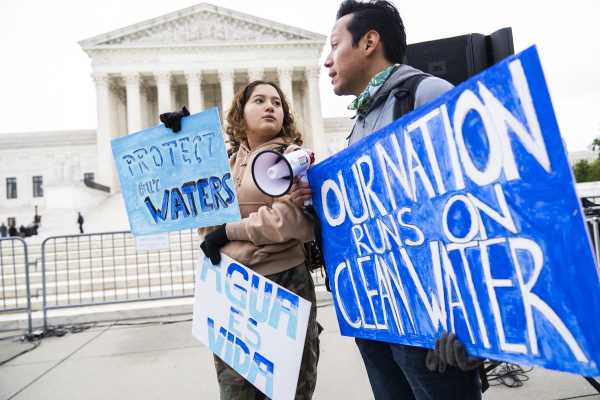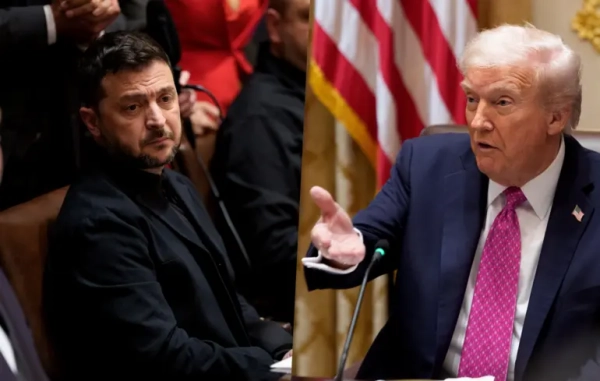
Sackett v. Environmental Protection Agency, which the Supreme Court heard on Monday, is a devilishly difficult case. It involves the proper meaning of a vague phrase in the Clean Water Act, the principal law protecting America’s waters from a wide range of foreign substances.
That 1972 act prohibits “discharge of pollutants” into “navigable waters.” But it also defines the term “navigable waters” vaguely and counterintuitively, to include all “waters of the United States, including the territorial seas.” While nearly everyone agrees that major bodies of water such as rivers and large lakes qualify as “waters of the United States,” Sackett, which involves a couple that wants to fill in wetlands on their residential lot near an Idaho lake, asks just how closely a wetland must be connected to such a larger body of water before it is also subject to the Clean Water Act’s prohibitions.
A decision removing the act’s protections from even some wetlands could have significant implications for the nation’s water supply, as that nation’s water system is interconnected. A pollutant dumped in a wetland miles from a major lake can nonetheless migrate to that lake.
Help inform the future of Vox
We want to get to know you better — and learn what your needs are. Take Vox’s survey here.
On the eve of oral arguments in Sackett, the Court appeared likely to settle on one of two approaches suggested by two conservative justices in Rapanos v. United States (2006), the last Supreme Court case to consider how to define the term “waters of the United States.” But neither test seemed to satisfy a majority of the Court during Monday’s oral argument.
At least six of the justices expressed concerns that a narrow reading of the Clean Water Act suggested by Justice Antonin Scalia (who was joined, in 2006, by three of his fellow Republican appointees) in Rapanos is at odds with the act’s text. Indeed, a majority of the justices seemed so critical of Scalia’s approach — and of conservative lawyer Damien Schiff’s advocacy for that rule — that Schiff seemed to be headed for a loss when he sat down after presenting his first round of arguments to the justices.
Yet, if environmentalists thought they had reason to celebrate when Schiff left the podium halfway through Monday’s argument, those hopes were dashed not long after DOJ attorney Brian Fletcher began his oral arguments.
A majority of the justices appeared concerned that the alternative test Justice Anthony Kennedy proposed in Rapanos is too vague to be manageable. Worse, for environmentalists and for the government, the Court’s Republican-appointed majority appeared equally concerned that the federal government’s reading of the statute is too vague — and that it gives landowners too little warning about whether they will have to comply with the law.
The most likely result in Sackett, in other words, is that the Court will make a significant cut at the Clean Water Act, but perhaps not the deepest one that environmentalists feared before Monday’s arguments. It is less clear whether the justices will come up with a test to determine which waters are subject to the law that brings any real clarity to this difficult question.
The Court appears dubious of a narrow reading of the Clean Water Act proposed by Justice Scalia
Plaintiffs Chantell and Michael Sackett bought a residential lot near Priest Lake in Idaho, much of which consists of wetlands. They attempted to fill in these wetlands with sand and gravel, but the federal government told them to stop — on the theory that effectively destroying these wetlands would violate the Clean Water Act.
Although sand and gravel aren’t the sorts of things that many people ordinarily think of as pollutants, the Clean Water Act prevents the destruction of at least some wetlands because of the natural role wetlands play in protecting more significant bodies of water from pollution. Wetlands act as filters that trap pollutants that could otherwise infiltrate navigable waters. They also act as sponges to absorb floodwaters.
But the question of which wetlands qualify as “waters of the United States,” and therefore are protected by the Clean Water Act, turns out to be quite difficult. In Rapanos, four justices joined an opinion by Justice Scalia that would have excluded most American wetlands from the act’s scope. Under Scalia’s proposed test, a wetland is only subject to the act if it has a “continuous surface connection” with a “relatively permanent body of water” that makes it “difficult to determine where the ‘water’ ends and the ‘wetland’ begins.”
According to an amicus brief filed by professional associations representing water regulators and managers, Scalia’s test would “exclude 51% (if not more) of the Nation’s wetlands” from the act’s protections.
But many of the justices suggested on Monday that Scalia’s proposed rule from Rapanos is at odds with a provision of the Clean Water Act that indicates that the act does cover wetlands that are “adjacent” to navigable bodies of water.
Chief Justice John Roberts, for example, argued that a train station ordinarily is considered to be “adjacent” to the train tracks, even if those tracks do not literally touch the train station physically. Justice Brett Kavanaugh noted that, in 1977, the Army Corps of Engineers made it clear that a wetland may be “adjacent” to a body of water even if it is separated from that larger body by berms, dunes, dikes, or other such features. And Kavanaugh seemed to argue that Congress incorporated the Army Corps of Engineers’ understanding into the Clean Water Act itself.
As Justice Amy Coney Barrett told Schiff, “the biggest problem for you, clearly,” is that the law seems to encompass wetlands that are merely nearby a larger body of water, and not just wetlands that are so integrated into that body of water that it is “difficult to determine where the ‘water’ ends and the ‘wetland’ begins.”
The Court could ultimately settle on a rule that is even more restrictive than Scalia’s
Yet, while a majority of the Court did seem to shy away from Scalia’s proposed rule on Monday, all of the Court’s six Republican appointees appeared concerned with what Justice Samuel Alito referred to as a “vagueness problem.” Or, as Justice Neil Gorsuch put it, how is a “reasonable landowner” supposed to determine whether their land is covered by the Clean Water Act?
In Rapanos, Justice Kennedy proposed what is often referred to as the “significant nexus” test. Under this test, wetlands are subject to the act’s restrictions if they “significantly affect the chemical, physical, and biological integrity of other covered waters more readily understood as ‘navigable.’” But several of the justices fretted that this test is too vague to allow landowners to determine upfront whether they must comply with the law.
Which is not to say that landowners are helpless. As Justice Ketanji Brown Jackson pointed out, a landowner may ask the EPA to look at their land and determine if it is subject to the act before they begin a construction project on that land. And even if the act does apply, a landowner may still seek a permit allowing them to build despite the act’s restrictions.
But it is far from clear that a majority of the Court will deem these procedures sufficient to protect landowners.
Several members of the Court also seemed to have concerns that the provision of the Clean Water Act stating that “adjacent” wetlands fall within the scope of the act is also too vague. Could a wetland be “adjacent” to a lake if it was three miles away from it, Gorsuch asked at one point? What if it was just one mile away?
And the government’s proposed reading of the statute — that a wetland is covered if it is “in reasonable proximity to other waters of the United States” — doesn’t really do much to clear up this vagueness problem.
The ultimate problem facing the Court is that the statute itself does not draw a clear line that determines when a wetland is so far from a larger body of water that the act no longer applies. And without a clear line, the conservative Court is likely to determine that edge cases simply do not qualify.
Indeed, in the worst case for the government, the Court could declare much of the act void for vagueness. As Gorsuch has written, in a somewhat hyperbolic majority opinion for the Court, “In our constitutional order, a vague law is no law at all.”
In any event, it’s not yet clear that the Court will go quite that far. Most of the justices appeared to spend Monday morning struggling with how to read a law that gives them little clear guidance, at least with respect to close cases. How they resolve that remains to be seen.
Our goal this month
Now is not the time for paywalls. Now is the time to point out what’s hidden in plain sight (for instance, the hundreds of election deniers on ballots across the country), clearly explain the answers to voters’ questions, and give people the tools they need to be active participants in America’s democracy. Reader gifts help keep our well-sourced, research-driven explanatory journalism free for everyone. By the end of September, we’re aiming to add 5,000 new financial contributors to our community of Vox supporters. Will you help us reach our goal by making a gift today?
Sourse: vox.com






